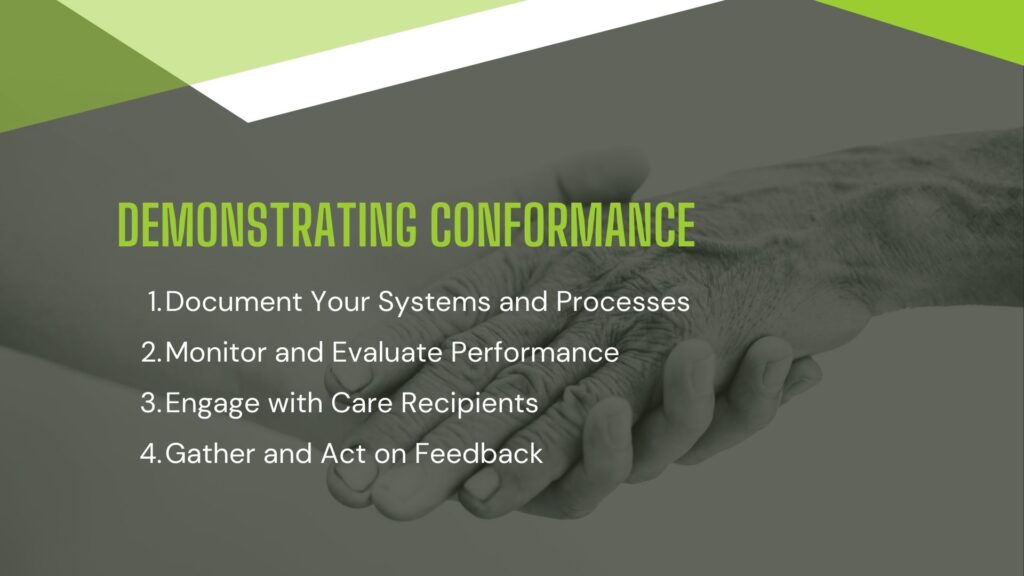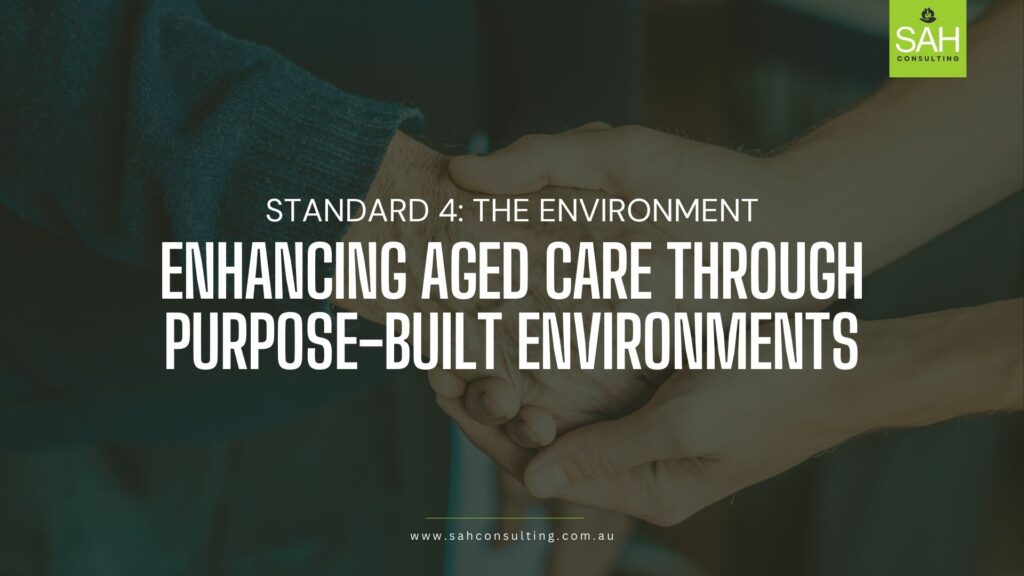The Support at Home Programme, due to launch in 2025, marks a big leap forward in Australia’s aged‑care reform. In this running series unpacking the Strengthened Aged Care Quality Standards, we’ve already covered how person‑centred care (Standard 3) shapes daily practise. For continuous improvement in aged care, we will now discuss Standard 4: The Environment—the benchmark for designing safe, purposeful spaces that protect older Australians’ dignity, independence and health.
What Standard 4 Means
Standard 4 states that every setting where care is delivered. Whether a client’s living room or a 120‑bed home, it must be safe, clean, comfortable and support everyday living. Infection prevention and control (IPC) should not just be bolt‑on. It should be woven through the entire environment to protect older people, visitors and staff. The Standard applies to providers registered in Categories 4, 5 and 6 under the new system.
For the elderly: “I feel safe and supported where I live.”
For workers: “I create a safe and supportive environment.”
Key Topics and Principles
Providers need to focus on critical areas to meet Standard 4:
Environmental risk assessment – Partnering with clients to spot and fix trip, fire or hygiene hazards builds trust and prevents harm. (Example: A care worker notices clutter around a favourite recliner, flags it, and co‑creates a tidy‑up plan with the resident.)
Well‑maintained service environment – Scheduled maintenance and clear accountability keep equipment reliable and residents confident. (Example: A lift malfunction is logged, escalated and repaired within 24 hours.)
Freedom of movement & accessibility – Dementia‑friendly cues and a barrier‑free design promote independence and reduce distress. (Example: Colour‑coded hallways guide residents back to their rooms without staff intervention.)
High‑quality IPC processes – Robust cleaning, safe waste disposal, and outbreak plans save lives and reputations. (Example: Routine UV‑verified surface audits back up cleaning checklists.)
Required Outcomes and Actions
Standard 4 contains three outcomes supported by six actions. One action (4.2.1) embeds a new expectation that every provider appoint an appropriately‑qualified Infection Prevention & Control (IPC) Lead.
Outcome 4.1a – Environment & Equipment at Home
Older people receiving care in their own dwelling are protected from environmental hazards and have access to safe, suitable equipment.
Actions:
- 4.1.1a Identify any environmental risks in the individual’s home, discuss them with the person and agree on mitigation options.
- 4.1.2a Ensure all aids and equipment supplied or used are safe, clean, well‑maintained and meet the person’s assessed needs.
Outcome 4.1b – Environment & Equipment in a Service Environment
Service premises (e.g., day centres, residential homes) are clean, safe, welcoming and designed so that people can move freely, belong and function at their best.
Actions:
- 4.1.1b Keep the service environment routinely cleaned, well‑maintained, safe, comfortable and fit‑for‑purpose.
- 4.1.2b Design and maintain spaces that are accessible (including for people with disability), promote movement, engagement and inclusion, enable free indoor‑outdoor access, and unobtrusively reduce safety risks while remaining easy to navigate.
- 4.1.3b Provide and maintain equipment that is safe, clean, well‑maintained and tailored to each individual’s needs.
Outcome 4.2 – Infection Prevention and Control
The provider operates a robust, evidence‑based IPC system and ensures workers apply hygienic practises in every setting where care is delivered.
Action:
- 4.2.1 Implement an organisation‑wide IPC system that:
1. Appoints a qualified IPC Lead.
2. Prioritises the rights, safety, health and wellbeing of individuals.
3. Aligns with contemporary, evidence‑based practise.
4. Defines standard & transmission‑based precautions (cleaning, hand hygiene, respiratory/cough etiquette, waste management, etc.).
5. Ensures appropriate PPE is available.
6. Supports correct PPE use by workers, individuals and others.
7. Includes surge measures for novel viruses and outbreaks.
8. Communicates and manages infection risks with individuals, supporters and staff.
9. Is informed by immunisation and infection‑rate data.
10. Applies risk‑based vaccine‑preventable disease screening and immunisation for individuals and workers.
11. Imposes screening and immunisation requirements for visitors.
Demonstrating Conformance

Complying with Standard 4 should be easy. Use this four‑step checklist:
Document Your Systems and Processes
Ensure all systems and processes are clearly documented to provide guidance and consistency across your service.
Monitor and Evaluate Performance
Use monitoring tools to track how your staff follow these processes and identify areas for improvement. Observe how care is provided to ensure standards are met.
Engage with Care Recipients
Work closely with the people receiving care to understand their experiences and outcomes. Their insight is key to improving your services.
Gather and Act on Feedback
Request feedback from your governing body, managers, workers, care recipients, and others involved. Use this feedback to refine and enhance your care and services.
Reflective Questions for Providers
These questions help aged care providers check how well they’re meeting the requirements of Strengthened Quality Standard 4. By answering them, providers can further pursue continuous improvement in aged care:
- How do you make sure the key points of this Standard are reflected in the care and services you provide to those receiving care?
- How do you collaborate with individuals receiving care to design the spaces where they access their services?
- How do you gather feedback from individuals receiving care to ensure they feel safe and that the environment supports their needs?
SAH Consulting: Guiding You Through Home Support Challenges
At SAH Consulting, we support aged care providers across Australia in navigating the Support at Home registration process with a focus on compliance and quality. Our expertise extends to meeting the Strengthened Quality Standards, particularly Standard 4: The Environment. We specialise in helping providers enhance care through purpose-built environments that promote safety, comfort, and inclusivity.
Our services include compliance audits, tailored policy development, and registration support. Understanding the importance of culturally safe and inclusive environments, we collaborate with providers to create spaces that foster dignity, wellbeing, and connection for all residents. Let us help you design care systems that truly make an impact.
Final Thoughts on Standard 4
Quality Standard 4 is the foundation of creating safe, functional, and purpose-built environments in aged care. It focuses on how organisations design and maintain spaces that promote safety, accessibility, and comfort while supporting person-centred care.
This Standard is more than just compliance—it’s about fostering environments that enhance quality of life, encourage independence, and reflect the dignity of those in your care.
At SAH Consulting, we’re here to help you transform compliance into meaningful action. Whether you’re preparing for Support at Home registration or looking to optimise your facilities to meet and exceed Standard 4 requirements, we’re ready to guide you every step of the way.
By helping you navigate registration and identifying examples of continuous improvement in aged care that you could follow, we can assist you in creating a culture of excellence that prioritises the needs and well-being of your residents. Reach out to us for a free consultation today!
